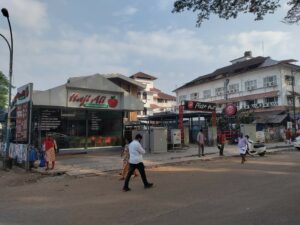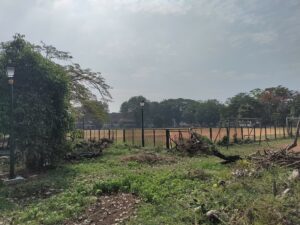Over the years, Fort Kochi’s tourism boom has been explosive. But its impact on local culture can only be seen through the eyes of native residents, who once called the township their home.

Fort Kochi’s streets have always welcomed the interests of out-of-town patrons. (Joshua Eugine/South First)
The rain trees that line the end of 50 Feet Road in the heart of Fort Kochi have been there for centuries. Watching generations pass by from the nearby Delta Study School, these trees now sit opposite a Pizza Hut outlet and a Haji Ali Juice Centre, offering a cool cover to upturned cobblestones and pavements yet to be laid.
Fort Kochi’s streets have always welcomed the interests of out-of-town patrons. But the recent radical upsurge in tourism has left the township in a commercial daze, struggling to remember a time when it was a neighbourhood of families, friends, and familiar faces.
Standing under the shade of a bright blue ‘Tourist Information’ sign, is Jose, the owner of Bounty Tours and Travels. He is one of the many people who has seen the eco-socio-cultural landscape of Kochi transform from the frontlines.

Pizza Hut and Haji Ali Juice Centre. (Joshua Eugine/South First)
“This was all a residential area,” he tells South First, pointing around the square where Princess Street meets Bastian Street.
“The cafe above our travel agency was originally the house of a family. Now, they’ve sold it and moved out,” he reveals, as we hear the sounds of lunchtime being observed at Loafers Corner Cafe.
Many residents of Fort Kochi left the neighbourhood in the last decade, selling their homes to hotel owners, explains author and Fort Kochiite Tanya Abraham.
“This change is quite stark,” she says. “It’s clearly a tourist town now.”
Even as newer hotels nudge their way into the area, the Old Harbour Hotel still stands tall on Tower Road with the magnificence with which it was built almost 300 years ago.
But during its tenure, it was once home to the Sen family in the early 1980s when the establishment was briefly leased out by a tea company which made it their officers’ residence.
“We used to call it Old Harbour House!” exclaims Sreeya Sen.
Back in 1983, when Sen was an 8-year-old at the nearby Delta Study School, she was living the best years of her life in Fort Kochi.
“There were neighbours all around us, and we all knew each other. I remember it so well because there was so much warmth, friendliness, and community living,” she reminisces.
To the left of Old Harbour, equalling it in legacy and beauty is Koder House — once the home of the Koders, a well-known Jewish family of Kochi.
“We knew the Koders and used to visit them very often,” Sen shares.
“Every Friday, they used to have an open house, where they’d invite all the neighbours for wine and Jewish mutton patties,” she recalls.
Although Koder House is still an icon of Kochi’s heritage, the PlanB House of Wings outlet it currently holds struggles to invite visitors with the intimacy that once graced the building.
“It wasn’t like this in my school days,” shares 24-year-old Chris, a current resident of Fort Kochi.
“Because of the oversaturation of tourists, it doesn’t feel as connected anymore,” he tells South First.
Chris’ statement is met with a firm nod by 39-year-old Anil Bhat, an ex-resident of the area, who has now moved inland towards Ernakulam, following many of the older natives.
Hailing from two different generations, both Anil and Chris have witnessed the slow demise of their hometown’s local aura.

To Bhat, many of the public spaces that were once occupied by his friends and neighbours have now undergone complete commercial transformation. And for Chris, it was nothing short of an eviction.
“Sometimes it feels like I’ve been driven out of my own home,” says Chris.
“Most of our hangout spots have disappeared,” he reveals, gesturing towards the area where a memory of the Aquatic Club rests under the construction site for the upcoming water metro station.
“Places to sit down peacefully by the waterside are decreasing. The few that are there have now become expensive private spaces,” he adds, revealing that the cost of living in Fort Kochi is drastically rising.
Property ownership and residence in Fort Kochi come with their own complications. “Even if you manage to buy property here, you can’t do much with it,” Bhat says, as more people find it burdensome to invest in Fort Kochi.
As many buildings and spaces are decreed heritage status, long lines of bureaucratic hoops prevent owners and occupants from making any architectural changes, even if it is in the interest of preservation.
Jose from Bounty Tours and Travels and Madhu from Spencer Home operate out of such spaces and reveal with resignation that there is little to no interest from the government to initiate conservation efforts.

The Parade Ground has been neglected since its makeover in 2017 when the FIFA U-17 World Cup was held in India. (Joshua Eugine/South First)
“There has been a lot of unregulated work with no adherence to heritage,” adds Abraham.
“Public spaces have been changed without design thought. It (heritage conservation) requires some hard laws from the government’s end, and education too — to locals and government officials,” she shares.
Walking along the rusted fence that surrounds the now patchy Parade Ground, Bhat reveals how the area has been neglected since its makeover in 2017 when the FIFA U-17 World Cup was held in India.
But true to the spirit of the neighbourhood, people still visit the ground every day to play like they always have, says Madhu, who works at Spencer Home.
Madhu is, however, dreading the arrival of the Kochi Carnival, which will take over the whole town, ending at Parade Ground with the burning of a massive Santa Claus effigy.
Bhat and Chris both remember the now-iconic Kochi Carnival as it once was — a celebration of, by, and for the neighbourhood of Fort Kochi.
“During the carnival, every house became our place,” Bhat recalls.
The carnival routine in the late 80s and 90s involved starting from Pandikudy, walking across 50 feet road and dancing in front of every house on the way, which would welcome them with music, snacks, and even a peg or two.
“It was more participative as I grew up too. I barely see any locals now,” shares Chris.
Chris and his friends still celebrate by themselves, wearing outrageous costumes as tradition demands, but the sincere enjoyment has been replaced by a sense of obligation.
“We do that now because we feel like we have to do it; because we’re trying to keep the spirit of the past alive,” Chris adds.
“Over the past 3-4 years, we’ve seen a few fights break out during the carnival,” Chris reveals.
Tourists from outside the district have been lured by the carnival’s appeal as well as Kochi’s larger hospitality and casual acceptance of having a good time.
“Many of them come from other places to join us so, we naturally welcome them, often offering them a drink. But they exploit this and behave inappropriately with us and our families,” Chris says.

Princess Street. (Joshua Eugine/South First)
Both Bhat and Chris admit that popular media often portrays Fort Kochi in an extreme light, limiting it to just local legends of gangs and gundas.
“A lot of the people who come here arrive with this misconception and find it thrilling to provoke us,” shares Chris.
Madhu worries that most of the youngsters who come to Kochi nowadays are driven by an urge to party. Very few are interested in discovering or at least respecting the culture of the locality in the process.
“Fort Kochi is trying to modernise and promote heritage tourism at the same time,” reveals Bhat, explaining how this warped fusion is resulting in cultural confusion.
Unlike other tourist destinations like Goa, where certain parts still retain their old charm and other areas have embraced commercial tourism, Fort Kochi has attempted to mix both.
“It seems to be a goulash of everyone’s ideas that the true essence of the place is being replaced with construction and unthought-of tourism-based ideas,” explains Abraham.
This obsession with what commercially works has led to the establishment of countless corner cafes whose aesthetic and menu conveniently fit into a template that guarantees sales from the biggest buyer.
“Ironically, you find the least amount of local food within the major tourism locality,” shares Chris.
Bhat and Chris reveal that only certain areas like Cherlai and Mattancherry continue to have food joints serving the regular, everyday food of Kochi natives.
“It’s funny,” says Bhat, “if you visit England, you’d order an English breakfast. But now if you come to Fort Kochi, you still have to order an English breakfast.”
Kochi has undeniably been a tourist attraction all its life. And part of the appeal is its ability to embrace each zeitgeist.
Recently, Conde Nast Traveller named the city as one of the best places to visit in Asia in 2024. This accolade combined with the start of the tourist season is bound to put Kochi on the maps of every backpacker, travelling artist, and package tour agency.
“A lot of these people come from outside, widening the city and opening its doors to various influences,” shares Dilip Narayan, who runs Gallery OED on Bazaar Road.



Like others, Dilip identifies commercial landmarks that are alien to the larger local culture but recognises a few positive changes.
“In our art and culture, we are still rich because now there is a lot of fusion and experimentation with other influences,” informs Dilip.
“Kochi is filled with travellers, not tourists,” says Dilip, revealing that the former crave authenticity, and their repeated visits only signal that Fort Kochi retains a large part of its originality.
Local residents are well known for their hospitality and encourage visitors to mindfully partake in the town’s everyday lived experience.
With the carnival around the corner, visitors are requested to be respectful of the local communities and to keep their surroundings clean.
“As Fort Kochiites, we tried our best to take this a certain route and protect the heritage,” shares Abraham, to whom Kochi’s popularity must be carefully monitored.
This route has seen many individuals over the years. Some have left the town and some stay back, trying to hold on to why they continue to call Kochi their home.
For Sreeya Sen, returning to Kochi after almost 40 years made the city seem unrecognisable.
To Anil Bhat, each corner that once held a local legend instead of a cafe is a sign of a dying neighbourhood, which Chris and his friends struggle to resuscitate.
From the perspective of Dilip Narayan, Kochi is inviting a new band of residents into its cultural consciousness.
To the rain trees that stand in front of Nehru Park and alongside the 50-foot road, life goes on as it had 300 years ago, watching yet another generation settling into the land they call home.

Jul 26, 2024

Jul 26, 2024

Jul 25, 2024

Jul 25, 2024

Jul 25, 2024

Jul 24, 2024